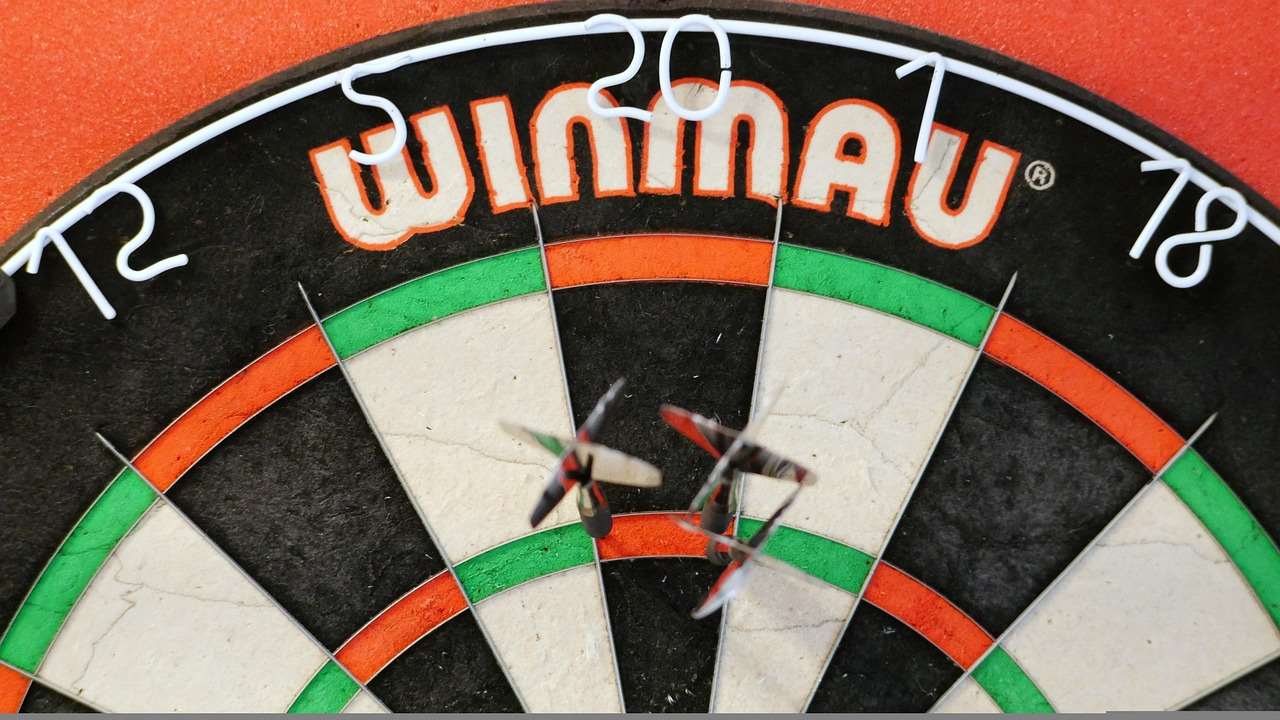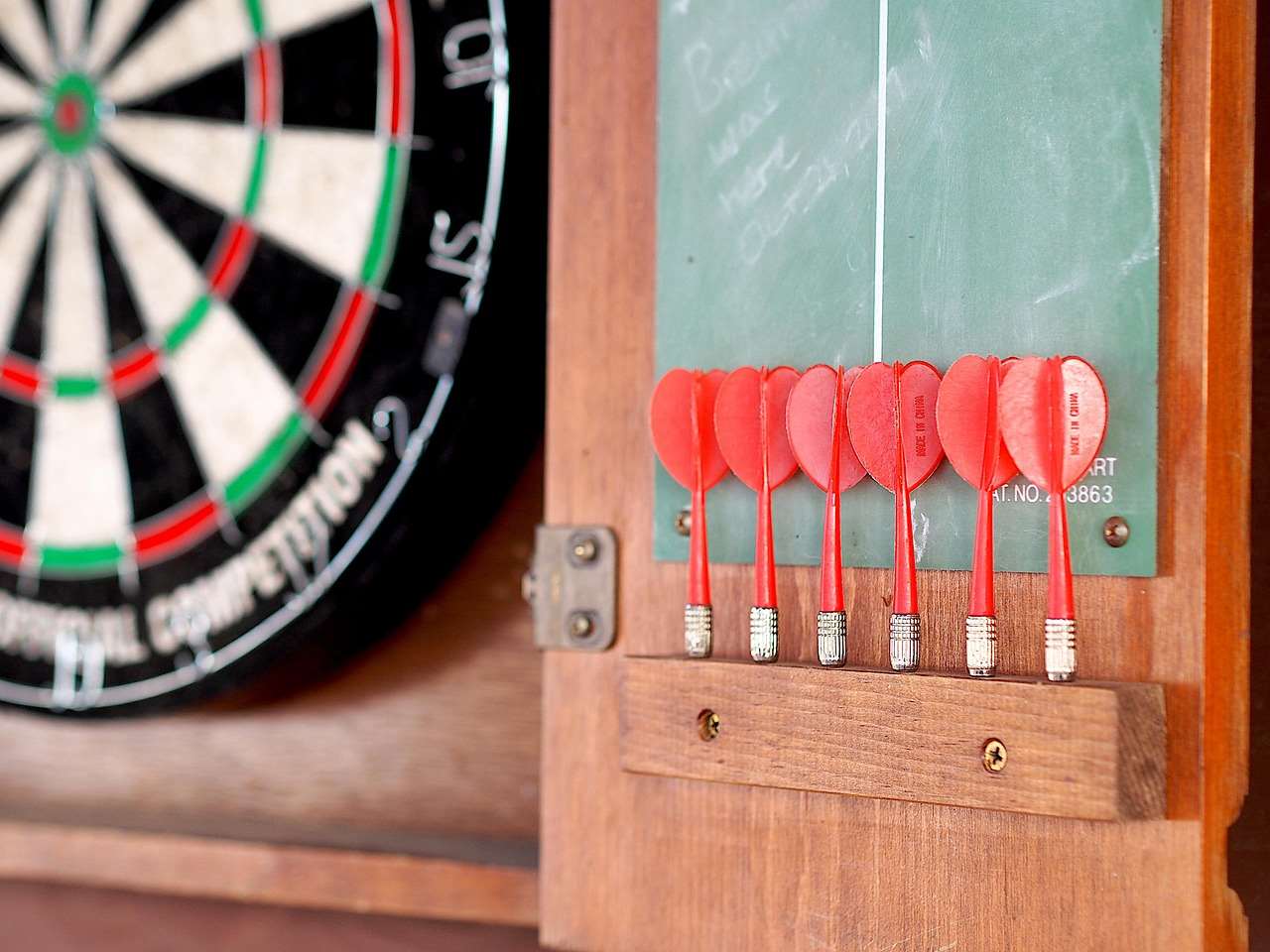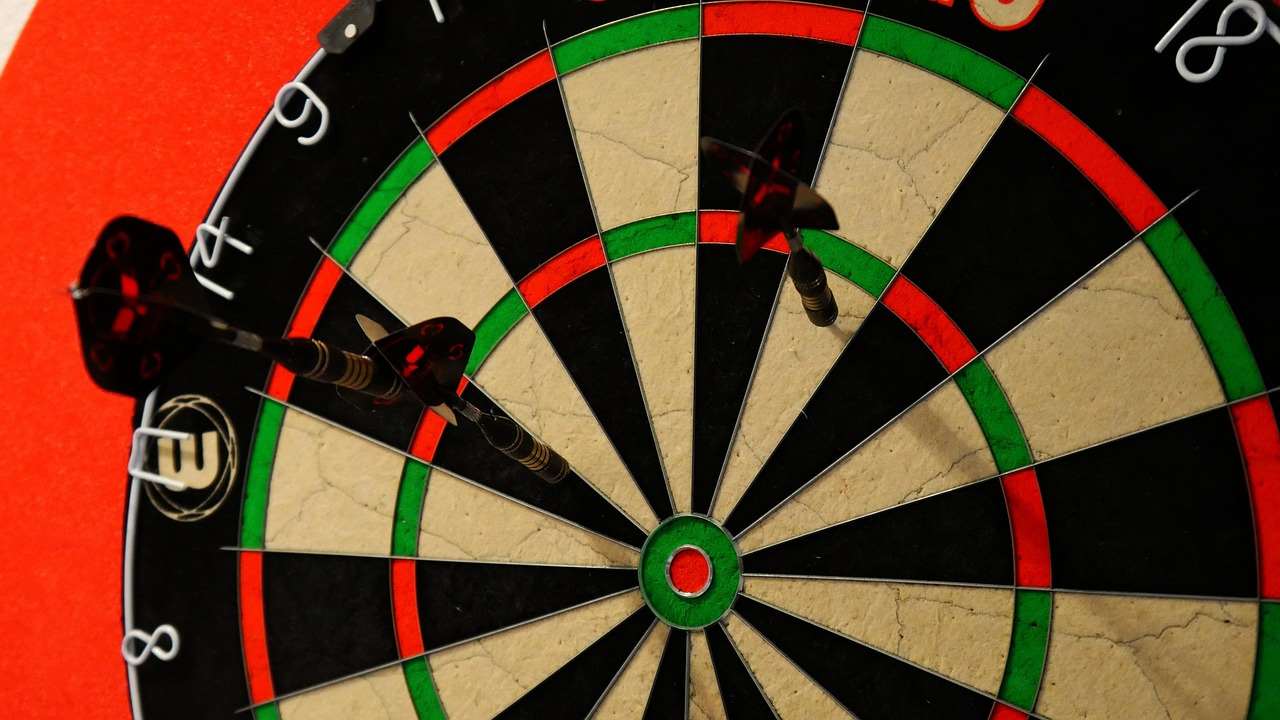Mastering the Cricket darts number order strategy is key to winning more games, as it dictates how efficiently you close numbers and control the board; prioritizing higher numbers first to establish dominance and force your opponent into defensive plays is often the best approach. This article will explore various Cricket darts strategies, including number selection, defensive tactics, and closing strategies, helping you elevate your game and consistently outscore your opponents.
⚠️ Still Using Pen & Paper (or a Chalkboard)?! ⚠️
Step into the future! The Dart Counter App handles all the scoring, suggests checkouts, and tracks your stats automatically. It's easier than you think!
Try the Smart Dart Counter App FREE!Ready for an upgrade? Click above!
Understanding the Basics of Cricket Darts
Cricket is a strategic darts game where players must “close” specific numbers (20, 19, 18, 17, 16, 15, and the bullseye) by hitting them three times each. A number is considered closed when a player has hit it three times and their opponent hasn’t. The goal is to close all required numbers and have a lower score than your opponent. Understanding the core rules and scoring in Cricket is paramount before diving into advanced strategies.
Unlike some other dart games, cricket places heavy importance on both offensive and defensive strategies. You can aggressively target high-scoring numbers to quickly close them out, or defensively block your opponent by closing numbers they need. Effective number selection is key, which leads us to a discussion on the optimal number closing order.

The Optimal Cricket Darts Number Order Strategy
There’s no single “best” Cricket darts number order strategy, as the ideal approach can vary depending on your skill level, your opponent’s skill level, and the current state of the game. However, a common and effective strategy is to prioritize higher numbers first.
Here’s a breakdown of why this strategy often works:
- High Scoring Potential: Numbers like 20 and 19 offer the potential for quick scoring, allowing you to build a lead and put pressure on your opponent.
- Defensive Advantage: Closing higher numbers early can force your opponent into defensive positions, making them scramble to close those numbers before you can score on them.
- Psychological Impact: By quickly closing high numbers, you can create a sense of dominance and potentially demoralize your opponent.
However, it’s crucial to adapt your Cricket darts strategy based on the specific circumstances of the game. Sometimes, it might be advantageous to target a lower number if your opponent is close to closing it, or if you feel more confident in your ability to hit that number consistently. Sometimes Darts for mixed ability groups require flexible thinking.
Prioritizing Higher Numbers: A Closer Look
The most frequently employed Cricket darts number order strategy starts with the 20 and 19, followed by 18, 17, and then the bullseye. The 15 and 16 are often left for later due to their relative lower scoring potential. This tactic allows a player to quickly establish control over the board.
Let’s consider a scenario: if you close the 20 quickly, your opponent must either close the 20 themselves, or they risk you scoring heavily on that number. This applies pressure and forces them to react to your game, limiting their own offensive opportunities.
If your opponent is a weaker player, focusing on high numbers can be even more effective, as they may struggle to consistently hit those numbers, allowing you to capitalize on their misses. This is important for Scaling dart game difficulty appropriately.
Defensive Strategies in Cricket Darts
While offense is important, a strong defense is crucial for winning in Cricket. Defensive play involves preventing your opponent from scoring and closing numbers they need. Mastering defensive tactics can significantly improve your overall cricket darts performance.
Here are some key defensive strategies:
- Blocking Numbers: If your opponent is close to closing a particular number, prioritize hitting that number to deny them the opportunity to score.
- Targeting Opponent’s Weaknesses: Identify numbers your opponent struggles with and focus on closing those numbers to limit their scoring potential.
- Strategic Scoring: Sometimes, it’s better to avoid scoring on a number if it will give your opponent an advantage. For example, if your opponent is close to closing all the numbers and has a lower score than you, you might want to avoid scoring and focus on closing the remaining numbers.
Consider the following example: your opponent has two marks on the 19 and is poised to score heavily. By hitting the 19 just once, you force them to get two more hits to close the number, denying them the easy score and disrupting their game plan. That’s good use of Adapting darts games skills.
Adapting Your Strategy: Recognizing Game Dynamics
A rigid adherence to a single Cricket darts number order strategy can be a downfall. The best players are adaptable and adjust their approach based on the flow of the game. Recognizing when to switch between offensive and defensive tactics is key to success.
Factors to consider when adapting your strategy include:
- Your Opponent’s Skill Level: A weaker opponent may warrant a more aggressive strategy, while a stronger opponent may require a more defensive approach.
- The Current Score: If you’re significantly behind, you may need to take more risks to catch up. If you’re ahead, you can afford to play more defensively.
- Number Availability: If a particular number is already partially closed by you or your opponent, adjust your focus accordingly.
- Darting Accuracy: On days when your accuracy isn’t at its peak, focusing on larger targets and easier numbers might be wise.
For example, if you’re having a bad day and struggling to hit the 20, it might be wiser to switch your focus to the 19 or 18, where you feel more confident. Remember, cricket isn’t always about hitting the highest numbers; it’s about strategically closing numbers and outscoring your opponent using a smart Cricket darts number order strategy.

Advanced Cricket Darts Techniques
Beyond basic number selection and defensive play, several advanced techniques can further enhance your cricket darts proficiency.
- The “Setup” Shot: Intentionally leaving a number open with one or two marks, allowing you to score on that number in the next round. This can be a powerful offensive tactic.
- The “Double Down”: Hitting a double on a number to close it with a single dart, conserving darts for other numbers.
- Strategic Misses: Deliberately missing a number to avoid giving your opponent an advantage, especially if they are close to closing the game.
The setup shot, for instance, allows you to control the pace of the game and dictate the numbers in play. However, it also carries risk. If you miss the setup shot, you’ve given your opponent a free opportunity. The Darts Variants Fun Games are often a way of learning these techniques.
Practice Drills for Mastering Number Order
Consistent practice is essential for developing a strong Cricket darts number order strategy. Incorporate these drills into your practice routine to improve your accuracy and decision-making skills.
- Target Practice: Focus on consistently hitting the 20, 19, and 18 to improve your accuracy on the higher-scoring numbers.
- Closing Drills: Practice closing each number with three darts, focusing on hitting the single, double, and triple segments.
- Defensive Drills: Simulate game situations where you need to block your opponent from scoring, focusing on hitting the numbers they are close to closing.
- Game Simulations: Play practice games against yourself or a partner, experimenting with different Cricket darts number order strategies and adapting to different game scenarios.
The Mental Game in Cricket Darts
Cricket is not only a physical game but also a mental one. Staying focused, managing pressure, and making sound decisions are crucial for success. A clear mind helps in determining the best Cricket darts number order strategy to use at any given moment.
Here are some tips for improving your mental game:
- Stay Focused: Avoid distractions and concentrate on your target.
- Manage Pressure: Practice breathing techniques to calm your nerves during high-pressure situations.
- Positive Self-Talk: Encourage yourself and maintain a positive attitude, even when you make mistakes.
- Visualize Success: Imagine yourself hitting your targets and winning the game.
Furthermore, understanding your opponent’s tendencies can be a huge advantage. Are they aggressive or defensive? Do they have any obvious weaknesses? Use this information to tailor your strategy and gain a mental edge. Adjusting Adjusting dart game rules can impact the mental side of the game, as well.
Equipment and Setup for Cricket Darts
Having the right equipment and a proper setup can significantly impact your performance in Cricket. A good-quality dartboard, well-balanced darts, and proper lighting are essential for consistent play. The details of your **dartboard setup** matter.
Here are some key considerations:
- Dartboard: Choose a high-quality sisal dartboard with thin wires to minimize bounce-outs.
- Darts: Select darts that feel comfortable and balanced in your hand. Experiment with different weights and shapes to find the best fit.
- Lighting: Ensure adequate lighting to clearly see the dartboard and your targets. A dedicated dartboard light is a worthwhile investment.
- Throw Line: Position the throw line at the correct distance (7 feet 9 1/4 inches) from the dartboard.
A stable and well-lit setup allows you to focus on your technique and strategy without distractions, maximizing your chances of success with your chosen Cricket darts number order strategy.

Common Mistakes to Avoid in Cricket Darts
Even experienced players make mistakes in Cricket. Identifying and avoiding common errors can help you improve your consistency and decision-making.
Here are some common mistakes to avoid:
- Ignoring Defense: Focusing solely on offense and neglecting defensive opportunities.
- Predictable Strategy: Relying on the same Cricket darts strategy every time, making it easier for your opponent to anticipate your moves.
- Poor Number Selection: Choosing numbers without considering the current state of the game or your opponent’s weaknesses.
- Lack of Focus: Getting distracted or losing concentration during the game.
For example, if you consistently target the 20 without considering your opponent’s progress or your own accuracy, you may be missing opportunities to block them or close numbers more efficiently. A well-rounded game considers both attack and defense using a varied **Cricket darts number order strategy**.
Analyzing Professional Cricket Darts Games
One of the best ways to learn advanced Cricket darts strategies is to analyze professional games. Observe how top players choose their numbers, adapt to different situations, and utilize defensive tactics.
Pay attention to:
- Number Selection: Which numbers do they prioritize and why?
- Defensive Plays: How do they block their opponents and prevent them from scoring?
- Strategic Decisions: What factors influence their decisions throughout the game?
- Adaptability: How do they adjust their strategy based on the flow of the game?
By studying the pros, you can gain valuable insights and learn new techniques to incorporate into your own game, improving your overall understanding of Cricket darts number order strategy.

Conclusion: Elevating Your Cricket Darts Game
Mastering the Cricket darts number order strategy is a journey that requires dedication, practice, and a willingness to adapt. By understanding the fundamentals, incorporating defensive tactics, and analyzing professional games, you can significantly improve your skills and consistently outperform your opponents. Remember to practice consistently, stay focused, and adapt your strategy based on the specific circumstances of each game. The key is to understand the nuances of the game, and use strategy to your advantage. Now, grab your darts, implement these strategies, and dominate the cricket board!
Take your cricket game to the next level! Head to your local dart supply store or browse online for quality darts and boards. Ready to refine your skills even further? Check out our other articles on advanced dart techniques and strategy today!
Hi, I’m Dieter, and I created Dartcounter (Dartcounterapp.com). My motivation wasn’t being a darts expert – quite the opposite! When I first started playing, I loved the game but found keeping accurate scores and tracking stats difficult and distracting.
I figured I couldn’t be the only one struggling with this. So, I decided to build a solution: an easy-to-use application that everyone, no matter their experience level, could use to manage scoring effortlessly.
My goal for Dartcounter was simple: let the app handle the numbers – the scoring, the averages, the stats, even checkout suggestions – so players could focus purely on their throw and enjoying the game. It began as a way to solve my own beginner’s problem, and I’m thrilled it has grown into a helpful tool for the wider darts community.